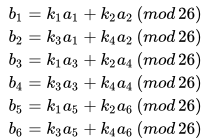Answered step by step
Verified Expert Solution
Question
1 Approved Answer
THE QUESTION IS BASED ON THE FIRST QUESTION ! BUT I NEED A HELP WITH QUESTION 2 ONLY THANK YOU Suppose we define an encryption
THE QUESTION IS BASED ON THE FIRST QUESTION ! BUT I NEED A HELP WITH QUESTION 2 ONLY THANK YOU
Suppose we define an encryption scheme as follows. The key will be four elements k1,k2, k3 and k4 in  26. The message space will be sequences of elements of
26. The message space will be sequences of elements of  26 of length 6. The ciphertext space will be the same as the message space.
26 of length 6. The ciphertext space will be the same as the message space.
The encryption algorithm is the following. Given a key k1, k2, k3and k4 and a message , (a1,a2, a3, a4, a5, a6 ), the corresponding ciphertext is (b1,b2,b3,b4,b5, b6) , where:

Step by Step Solution
There are 3 Steps involved in it
Step: 1

Get Instant Access to Expert-Tailored Solutions
See step-by-step solutions with expert insights and AI powered tools for academic success
Step: 2

Step: 3

Ace Your Homework with AI
Get the answers you need in no time with our AI-driven, step-by-step assistance
Get Started


